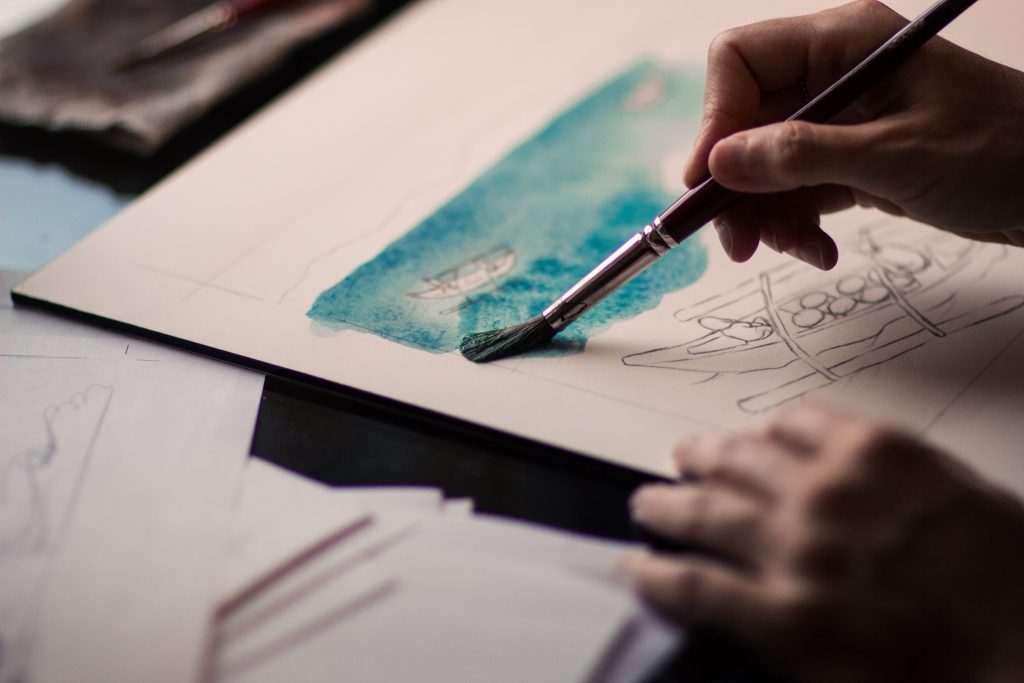Let’s Get Creative: Why Art Therapy Is An Effective Tool in Recovery
Taking the First Step in Art Therapy
When I walk through the door to facilitate an art therapy group, I often get mixed responses from my clients. Some love art therapy and feel comfortable with creative mediums; being in a group where they do not have to use words to share can be a breath of fresh air. But others may feel nervous at the thought of having to create. The pressure to create something outside of themselves can be very uncomfortable. When clients allow themselves space to create, healing can take place. I have had the privilege of being a witness to this healing process. I have personally observed clients who struggle to identify feelings or process trauma using other therapeutic modalities achieve breakthroughs using creative mediums. I have watched them put pain and suffering on what was once a blank page and, after having filled that blank page with creative expressions of their struggles, conclude with improved mental well being.

Many treatment settings find art therapy - in addition to other creative art therapies such as music and dance - essential for supportive healing. There is a growing body of literature supporting the use of creative art therapy in treatment for individuals healing from trauma. Research demonstrates a strong link between exposure to traumatic events and substance abuse problems. Many people who have experienced child abuse, criminal attack, disasters, war, or other traumatic events turn to substance use to assist them in coping and managing emotional pain, painful memories, impacted sleep, guilt, shame, anxiety, or terror.
7 Reasons To Use Art Therapy
- Improving Self Management
- Loss of control is a common side effect of addiction. Art therapy strengthens skills to focus, build discipline and live a more balanced lifestyle.
- Combating Depression
- Art therapy can help combat chemical imbalances in the brain that may lead to depression. It also fosters positivity and optimism.
- Reducing Stress
- Drugs, alcohol and mental health struggles can often be the result of “de-stressing”. Art therapy can help develop positive habits that promote lasting health.
- Building Self Esteem
- Studies suggest that people with more confidence and social skills are more likely to develop healthy habits in their lives. Art therapy builds self-esteem, which is necessary to handle different social situations and life events.
- Addressing Past Traumatic Experiences
- Often, people who suffer from substance abuse are attempting to block out traumatic and painful experiences of the past. Art therapy allows a person to express their feelings and about the event and steps significant steps towards their recovery goals.
- Improving Communication Skills
- Art therapy fosters self expression and can deepen communication skills as well as the ability to connect with others.
- Mitigating Symptoms
- Art therapy can help mitigate symptoms related to physical and mental disorders, such as a reduction in pain, stress and irritability levels during recovery.

Art Therapy, The Brain and Overcoming ACE
The correlation between trauma and substance abuse was highlighted in 1998, when the remarkable results of “The Adverse Childhood Experiences Study” were published. The report uncovered a definitive link between childhood trauma and chronic diseases, substance use, and mental illnesses that people develop as an adult. The Substance Abuse and Mental Health Services Administration reports that Adverse Childhood Experiences (ACE) increase the likelihood of lifetime illicit drug use, drug dependency, and self-reported addiction up to four times! They also increase the chances of early alcohol, prescription drug, and tobacco abuse (Douglas, Chan, Gelernter, Arias, Anton, Weiss, & Kranzler, 2010). Many people find themselves in a vicious cycle in which exposure to traumatic events produces the need for coping using substances which lead to shame and dependence. Just as traumatic events and substance use often occur together, so do trauma-related disorders and substance-use disorders.

When we experience a traumatic event, the part of our brain that is responsible for language, the Brocas area, shuts down. At the same time, our brain’s danger recognition center, the amygdala, goes on high alert and records the traumatic memory visually and in the form of bodily sensation (Baker, 2018). Using art to express emotion accesses both visually stored memory and body memory. It not only empowers people to create images, but the use of art materials such as clay and paint, can reconnect them to physical sensation. Some may be cut off from their bodily senses, particularly in cases of physical and sexual abuse. Researchers have suggested that the senses of touch and sight connect directly to our brain’s fear center (Baker, 2018), which is why art therapy is ideal in working with traumatic memory.

There is a growing amount of research on trauma, substance abuse, and therapy that supports the use of creative art therapy. This research, in addition to my personal observations of the benefits and breakthroughs of this modality, supports the continuous need for facilitation of these groups in treatment settings. At West Coast Recovery Centers, Art Therapy continues to be a treatment continually made available to our clients. Moreover, art is an intrinsic part of the Carlsbad community, where our treatment has been located since 2011. In many ways, our programs are a reflection of the wonderful environment and community that we are privileged to be a part of every day.
References:
Baker, F. A., Metcalf, O., Varker, T., & O’Donnell, M. (2018). A systematic review of the efficacy of creative arts therapies in the treatment of adults with PTSD. Psychological Trauma: Theory, Research, Practice, and Policy, 10(6), 643–651. https://doi.org/10.1037/tra0000353.supp (Supplemental)Douglas, K. R., Chan, G., Gelernter, J., Arias, A. J., Anton, R. F., Weiss, R. D., … Kranzler, H. R. (2010). Adverse childhood events as risk factors for substance dependence: partial mediation by mood and anxiety disorders. Addictive behaviors, 35(1), 7–13. doi:10.1016/j.addbeh.2009.07.004

We work with most major insurance companies on an in-network basis.
